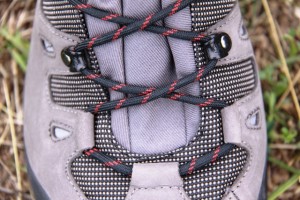
By Rick Shandley
Salomon’s Quest 4D GTX is a backpacking boot designed with the light weight of a running shoe. Like many tough, new, and advanced hiking/backpacking boots, the Salomon Quest 4D is constructed with a combination of both leather and textile material. This combination reduces boot weight, resists abrasion, provides ventilation and still offers a waterproof layer between your foot and the elements. The pair of size 13 Quest 4D’s this writer tested weigh 3.3 pounds or 1.5 Kg. That’s pretty light for a pair of sturdy three-season backpacking boots.
Hikers and backpackers that enjoy moving swiftly on the trail will love the Quest 4D GTX boots. They really are light. You can walk fast as you like, the boot weight will not slow you down. You could even run in them if the inclination strikes you, and there are times when you might do just that. The Quest feels like an all terrain running shoe. It is just built a little more robust with good support for your ankles and stability for your feet.
These Salomon Quest 4D GTX boots were worn on moderate-length hikes, and overnight hikes with a moderately loaded backpack in the 30-to-40 pound range. In rocky, uneven terrain, the Quest uppers provided good support and worked well with the 4D™ Advanced Chassis. This Molded EVA midsole is moderately stiff and provides good stability on uneven trail conditions with lots of rocks, loose soil, and sometimes slippery trail scenarios. OrthoLite® sock liners and EVA heel cups combine to cushion and support your feet while providing a long lasting healthy environment that won’t break down over time.
Daylong comfort and great traction are two characteristics of the Salomon Quest 4D boots that stood out. No boot is perfect for every hiking situation, but the Quest 4D’s are likely to appeal to a broad range of hikers and backpackers who don’t need a super technical, specialized boot. If you plan on staying on the marked trails and carrying light to moderate pack weights, the Quest 4D may be a solid choice for you. Both the toe and heel of the Quest are armored with rubber caps to blunt the impact of trail objects and resist abrasion from constant contact with loose, rocky terrain.

The lacing system of lace hooks and eyelets worked well. And the lace system is something you need to consider for any boot you might use on the trail. If the eyelets are too small in diameter, the lace up is slow and the friction created of the boot lace against the side edge of the eyelet or lace hook will shred the boot lace sooner than later. With the Quest, lace up is quick, the boot stays snug, and there is enough diameter built into the Salomon Quest eyelets and lace hooks to accommodate aftermarket boot laces once the originals wear out or break.
To say the Quest 4D’s are comfortable is an understatement. In my experience with these boots, they are good to wear every day, all day long. At no point during the weeks of short to fairly aggressive trail days did these Salomon Quest boots wear my feet out. Once they were laced up, they stayed on my feet until the day was done. My feet didn’t get sore, blistered, or cause me to think about their well being. If you could measure comfort on a scale of one to 10, Quest gets the highest mark.
Comfort aside, the Quest 4D offers good ankle and foot support, but it doesn’t have the rigidity or stiffness to “edge” on rock ledges, handle heavy pack loads, or kick foot holds into hard snow or earth. They are not mountaineering boots, and not meant to be. Mountaineering boots, by design, are much more rigid. They’ll o fine for long approaches to climbing zones and back. Quest 4D’s offer several characteristics of a good mountaineering boot, but the tradeoff of a less rigid foot last and more flexible midsole make them a more comfortable boot, but not the foot protection and ability to climb and haul heavy pack weights that mountaineering boots are built for.

Waterproof Nubuck leather uppers form the core frame of the Quest 4D to provide strength to the boot and support for the feet and ankles. Nylon fabric fills in the voids to reduce weight. GORE-TEX® waterproof booties line the Quest to keep feet dry in wet conditions while allowing the feet to breathe in any weather. This combination of leather and nylon fabric offers advantages, in addition to light weight, such as comfort, minimal to no break-in time, good foot support, and durability.
Outsoles give you as much traction as any lug pattern on the market. With the design software and modeling capabilities of today’s technology, Salomon product designers came up with a lug pattern that works very well in all terrain types we encountered. There are good-sized cleats on the outer edges of the sole to grab onto the trail surface. Large lug voids on the inside of the soles allow mud, water, and loose soil to channel out and away from the boot, much like an automotive all-terrain tire is designed. There are also thoughtfully designed sipping slots on the outsole that act as fine edges to grab onto smooth rock or wet surfaces.
At an MSRP of $230.00, the Salomon Quest 4D are well made hiking/backpacking boots. They’ll provide amazing comfort regardless of how many days in a row you’ll wear them. Traction is superb for most trail and terrain types. And the foot and ankle support are solid. One thing most folks know about the Salomon brand is that the company knows how to design and build high-performance ski boots. The Quest 4D backpacking boot is another high-performance application of that Salomon know how.









